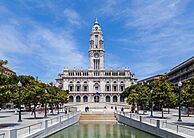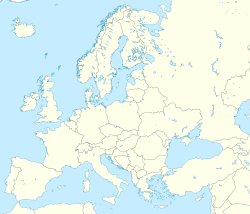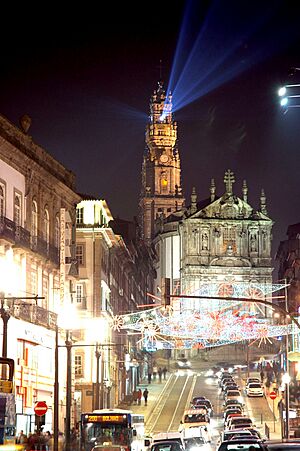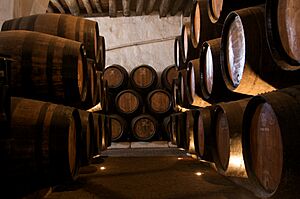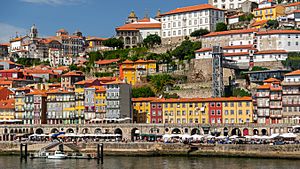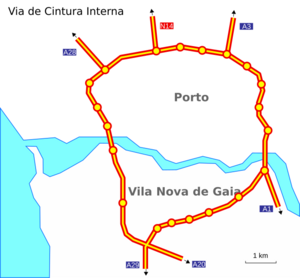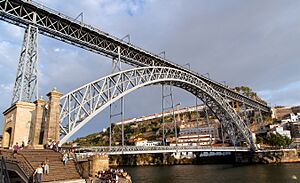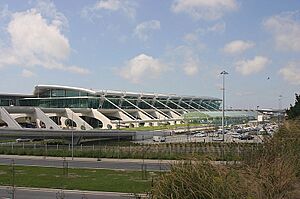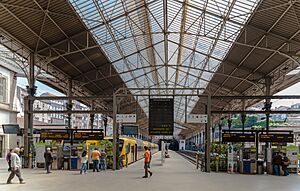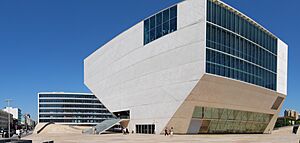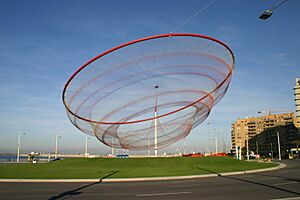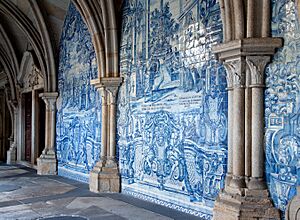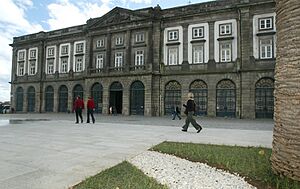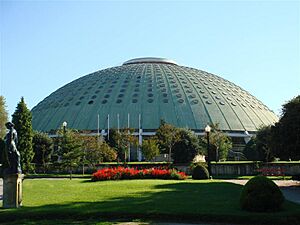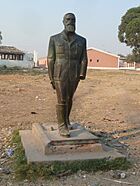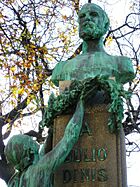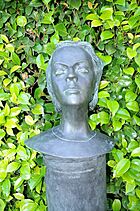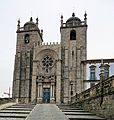Porto facts for kids
Quick facts for kids
Porto
Oporto
|
|||||
|---|---|---|---|---|---|
|
Municipality
|
|||||
|
View of Ribeira district and Dom Luis I Bridge from Vila Nova de Gaia
Casa da Música
City Hall
Palácio da Bolsa
Church of Saint Ildefonso
|
|||||
|
|||||
| Nickname(s):
A Cidade Invicta ("The Undefeated City"), A Cidade da Virgem ("The City of the Virgin") The Sandwich of Europe. (Vlog usage)
|
|||||
| Motto(s):
Antiga, Mui Nobre, Sempre Leal e Invicta (Ancient, Most Noble, Always Loyal and Undefeated)
|
|||||
| Country | |||||
| Region | Norte | ||||
| Subregion | Grande Porto | ||||
| District | Porto | ||||
| Settlement | 275 BCE | ||||
| Municipality | Porto | ||||
| Civil parishes | 7 | ||||
| Government | |||||
| • Type | LAU | ||||
| • Body | Câmara Municipal | ||||
| Area | |||||
| • Municipality | 41.42 km2 (15.99 sq mi) | ||||
| Elevation | 104 m (341 ft) | ||||
| Population
(2023)
|
|||||
| • Municipality | 248,769 | ||||
| • Density | 5,596.3/km2 (14,494/sq mi) | ||||
| • Urban | 1,375,679 | ||||
| • Metro | 1,802,664 | ||||
| Time zone | UTC0 (WET) | ||||
| • Summer (DST) | UTC+1 (WEST) | ||||
| Postal Zone |
4000-286 Porto
|
||||
| Area code(s) | (+351) 22 | ||||
| Demonym | Portuense, Tripeiro (informal) | ||||
| Patron Saint | Our Lady of Vendôme | ||||
| Municipal Holidays | 24 June (São João) | ||||
| Geographic detail from CAOP (2010) produced by Instituto Geográfico Português (IGP) | |||||
| UNESCO World Heritage Site | |||||
| Official name | Historic Centre of Oporto, Luís I Bridge and Monastery of Serra do Pilar | ||||
| Criteria | iv | ||||
| Inscription | 1996 (20th Session) | ||||
Porto (pronounced POR-too), also called Oporto, is the second largest city in Portugal. It is located along the Douro River in northern Portugal. Porto is known as "The Undefeated City" because of its history.
The city of Porto is quite old. Its historic center became a World Heritage Site by UNESCO in 1996. This means it's a very special place that should be protected. The name Portugal even comes from an old name for Porto, Portus Cale.
Port wine, a famous sweet wine, is named after Porto. This is because the wine was traditionally aged and shipped from here. Porto has also been named "The Best European Destination" multiple times.
Contents
- Porto's Story: A Look Back in Time
- Porto's Location and Look
- Who Lives in Porto?
- Porto's Economy: A Hub of Business and Trade
- Getting Around Porto: Transport Options
- Porto's Culture and Fun
- Delicious Food in Porto
- Learning in Porto: Education and Universities
- Sports in Porto: Football and More
- Porto's Sister Cities
- Famous People from Porto
- Images for kids
- See also
Porto's Story: A Look Back in Time
Ancient Beginnings
Long ago, Proto-Celtic and Celtic people lived in the Porto area. Later, the Roman Empire made it an important trading port. It was a key stop between what are now Lisbon and Braga.
Porto was also important when the Suebian and Visigothic people ruled. It became a center for spreading Christianity.
From Border Town to Kingdom's Birthplace
Around 714 AD, Muslims took control of the Iberian Peninsula. But by 741, Porto was taken back by Alfonso I of Asturias. This made Porto a border town.
Later, a count named Vímara Peres was given control of the area. This region, called Portucale, is where the name of modern-day Portugal comes from. In 868, Vímara Peres created the County of Portugal.
In 1093, the County of Portugal became part of a marriage dowry. It eventually grew into the independent Kingdom of Portugal in the 12th century.
A Strong Alliance and Brave Explorers
In 1387, an important wedding happened in Porto. John I of Portugal married Philippa of Lancaster from England. This wedding showed a strong, long-lasting military alliance between Portugal and England. It's actually the world's oldest recorded military alliance!
Porto's shipyards were very important for building ships. In 1415, Henry the Navigator, a Portuguese prince, sailed from Porto. His journey helped start the Age of Discovery, when Portuguese explorers sailed to new lands.
People from Porto are sometimes called tripeiros (tripe peoples). This nickname comes from these times. Sailors took the best meat, leaving the tripe for the city's residents. Today, tripe is still a special dish in Porto.
Port Wine and New Ideas
By the 13th century, wine from the Douro valley was brought to Porto. In the 18th century, the Methuen Treaty helped trade between Portugal and England. English companies started to control much of the port wine trade.
To fix this, Prime Minister Marquis of Pombal created a Portuguese company. He also marked out the region where port wine could be made. This was one of Europe's first attempts to control wine quality.
Between 1732 and 1763, the famous Torre dos Clérigos (Clerics' Tower) was built. This beautiful tower became a symbol of Porto.
The Undefeated City's Battles
In 1809, Napoleonic troops invaded Porto. Many people tried to escape across a floating bridge, the Ponte das Barcas. Sadly, the bridge collapsed, and thousands died.
Later, the Liberal Revolution of 1820 began in Porto. People wanted a king who would follow a constitution. A civil war followed from 1828 to 1834. Porto was under a long siege for 18 months. But the city successfully resisted, earning its nickname "Cidade Invicta" (Undefeated City).
Bridges and Modern Times
Porto is known as the "City of Bridges." Its first permanent bridge was built in 1806. Later, famous engineers like Gustave Eiffel designed bridges here. The Ponte Dom Luís I, built in 1886, is a beautiful double-deck bridge.
In 1891, a revolt against the Portuguese monarchy started in Porto. This led to the monarchy being overthrown and a republic being declared in 1910.
In 1996, Porto's historic center was named a World Heritage Site by UNESCO. In 2001, Porto was chosen as the European Capital of Culture. This led to many new buildings and improvements in the city.
Porto's Location and Look
Porto is about 280 kilometers from Lisbon. Its historic center is a World Heritage Site. The city has many amazing buildings.
The Porto Cathedral is the oldest building, dating back to the 12th century. You can also see the Church of Cedofeita and the Church of Saint Francis. Many buildings show the Baroque style, with fancy decorations.
Later, Neoclassical and romanticism styles appeared. Examples include the Palácio da Bolsa (Stock Exchange Palace) and the São Bento railway station. The station is famous for its beautiful Azulejo tiles.
Porto is divided into 7 main areas called civil parishes:
- Aldoar, Foz do Douro e Nevogilde
- Bonfim
- Campanhã
- Cedofeita, Santo Ildefonso, Sé, Miragaia, São Nicolau e Vitória
- Lordelo do Ouro e Massarelos
- Paranhos
- Ramalde
Porto's Weather: Sunny Summers, Rainy Winters
Porto has a Mediterranean climate. This means it has warm, dry summers. Winters are mild and rainy.
Summer temperatures are usually between 16°C and 26°C. Sometimes, it can get as hot as 38°C during heat waves. The beaches nearby are often cooler and windy.
Winter temperatures are usually between 6°C in the morning and 15°C in the afternoon. It rarely drops below 0°C at night. Winters are often rainy, but there are still many sunny days.
Who Lives in Porto?
| Nationality | Population |
|---|---|
| 8,307 | |
| 1,222 | |
| 749 | |
| 688 | |
| 607 | |
| 537 | |
| 530 | |
| 502 |
Porto has about 248,769 people living in the city itself. Its larger metropolitan area has around 1.8 million people. Most residents were born in Portugal.
There are more women than men in Porto. The largest age group is people aged 60 to 69. The city also has people from countries like Angola, Brazil, and Cape Verde.
Religion in the municipality of Porto (Census 2021) Catholicism (74.18%) Orthodoxy (0.26%) Protestantism (2.09%) Jehovah's Witnesses (0.58%) Other Christian (1.95%) Buddhism (0.25%) Hinduism (0.18%) Judaism (0.09%) Islam (0.42%) Other Religion (0.44%) No Religion (19.55%)
Porto's Economy: A Hub of Business and Trade
Porto is a big center for industry and finance in Portugal. Many large Portuguese companies have their main offices here. These companies work in different areas, like banking and publishing.
The city's old stock exchange is now a popular tourist spot. Its "Arab Room" is especially famous. Porto is also home to a major Portuguese newspaper, Jornal de Notícias.
The economy of Porto has always been linked to the Douro River. Products like olive oil and dried fruits were shipped from here. But the biggest boost came from the Port wine industry. The wine cellars in Vila Nova de Gaia, across the river, are key to this trade.
Porto is like a gateway to northern Portugal and parts of Spain. Many tourists visit the city and the surrounding areas.
Tourism: A Growing Industry
Tourism in Porto has grown a lot recently. The city has won "European Best Destination" awards multiple times.
Millions of visitors come to Porto each year. Most of them are from other countries. Tourism now makes up over 10% of Porto's economy.
Popular places to visit include the Porto Cathedral and the Dom Luís I Bridge. Other favorites are Café Majestic, Livraria Lello (a beautiful bookstore), and the gardens of the Crystal Palace.
Getting Around Porto: Transport Options
Roads and Bridges
Porto has a good road system with highways connecting it to other cities. It's known as the "City of Bridges" because of its many impressive bridges.
The Dom Luís I Bridge is a famous double-deck bridge. It crosses the Douro River between Porto and Vila Nova de Gaia. The top level is for metro trains and walkers. The lower level is for cars and walkers.
Other important bridges include the Arrábida Bridge and the Maria Pia Bridge, designed by Gustave Eiffel. The newest bridge is the Infante Dom Henrique Bridge.
Air Travel
Porto is served by Francisco de Sá Carneiro Airport. It's about 15 kilometers northwest of the city center. The airport was updated for the UEFA Euro 2004 football championships. You can reach the city center from the airport by metro.
Public Transport: Trains, Metro, and Buses
Railways
Porto's main train station is Campanhã railway station. From here, you can take trains to other parts of Portugal.
The central station is São Bento Station. It's a famous landmark known for its amazing Azulejo tiles. These murals show scenes from Portugal's history.
You can take high-speed trains from Porto to Lisbon. There are also trains to Vigo in Spain.
Light Rail (Metro)
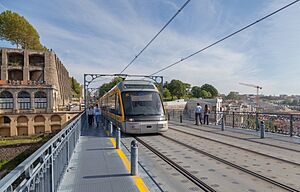
The Porto Metro is a modern light rail system. It has six lines that connect different parts of the city and nearby towns. The lines meet at the central Trindade station. The metro network is about 70 kilometers long and has 85 stations.
Buses and Trams
Porto has a large bus network run by STCP. These buses also serve nearby cities.
The city also has a historic tram network. Only three lines remain, mostly used by tourists. These trams use old-fashioned cars, making them a fun way to see the city.
Porto's Culture and Fun
In 2001, Porto was a European Capital of Culture. For this event, the amazing concert hall Casa da Música was built. It was designed by a famous Dutch architect.
Porto has a rich history in film. The first Portuguese moving pictures were taken here in 1896. Many famous Portuguese musicians are from Porto or nearby.
The city has many museums, theaters, and art galleries. The National Museum Soares dos Reis shows Portuguese art. The Serralves Foundation has a great museum of modern art.
The Lello Bookshop in Porto is often called one of the most beautiful bookstores in the world. Porto is also home to the largest synagogue in the Iberian Peninsula, the Kadoorie Synagogue.
Festivals and Events
Porto's most popular event is the St. John's Festival (Festa de São João) on June 23–24. People celebrate with sardines, boiled potatoes, and red wine. It's a tradition to have a pot of basil with a small poem.
Another big event is Queima das Fitas, which means "Burning of the Ribbons." It's a week-long celebration for university students before their final exams. Students march through the streets and enjoy concerts.
Art and Architecture
Porto has inspired many artists. Susanna Roope Dockery and Frederick William Flower created beautiful paintings and photographs of the city.
In 2005, a large public sculpture called She Changes was built on the waterfront. It was created by American artist Janet Echelman.
Porto is famous for its architecture. It has one of Europe's best architecture schools. Two architects from this school, Álvaro Siza Vieira and Eduardo Souto de Moura, have won the top architecture award, the Pritzker Architecture Prize.
Delicious Food in Porto
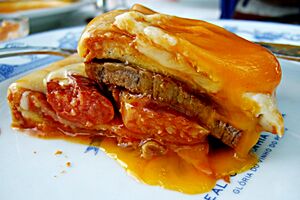
Porto has many tasty traditional Portuguese dishes. A classic dish is Tripas à Moda do Oporto (tripe Porto style). Bacalhau à Gomes de Sá (cod in the style of Gomes de Sá) is another popular codfish dish.
The Francesinha is Porto's most famous snack. It's a sandwich with different meats, covered in cheese and a special beer-based sauce.
Rojões (fried pork) and sarrabulho (a pig blood dish) are also popular. And, of course, Port wine is a famous dessert wine from the city.
Learning in Porto: Education and Universities
Porto has many schools for all ages. The Oporto British School is the oldest international school, founded in 1894. There are also French and German schools.
Higher Education Opportunities
Porto has several universities and colleges. The largest is the University of Porto, which is the second biggest in Portugal. It has about 28,000 students and is considered one of Europe's top universities.
Many students from all over Portugal come to Porto for college. For international students, there are many options to learn Portuguese.
Sports in Porto: Football and More
Football is the most popular sport in Porto. The city has two main teams: FC Porto and Boavista.

FC Porto is one of Portugal's "Big Three" teams. They have won the European Champions League twice and the UEFA Cup/Europa League.
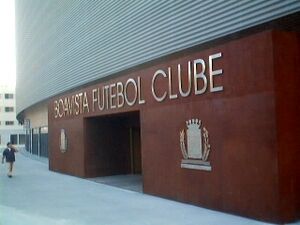
Boavista has won the Portuguese championship once.
The biggest stadiums are FC Porto's Estádio do Dragão and Boavista's Estádio do Bessa. Both stadiums were updated for the UEFA Euro 2004 football competition.
Porto also has other sports facilities. These include the Super Bock Arena and swimming pools. You can find sports like basketball, handball, and rugby here.
The city hosts the Porto Marathon every October. It also held Formula One races in the past.
Basketball Success
The FC Porto basketball team plays its games at the Dragão Caixa. They have won many championships in Portugal's top basketball league. Many of their players also play for the Portuguese national basketball team.
Porto's Sister Cities
Porto is twinned with many cities around the world. This means they share a special friendship and cultural exchange.
 Liège, Belgium (1977)
Liège, Belgium (1977) Ndola, Zambia (1978)
Ndola, Zambia (1978) Nagasaki, Japan (1978)
Nagasaki, Japan (1978) Recife, Brazil (1981)
Recife, Brazil (1981) Jena, Germany (1984)
Jena, Germany (1984) Bristol, England, UK (1984)
Bristol, England, UK (1984) Vigo, Spain (1986)
Vigo, Spain (1986) Beira, Mozambique (1989)
Beira, Mozambique (1989) Bordeaux, France (1990)
Bordeaux, France (1990) Duruelo de la Sierra, Spain (1989)
Duruelo de la Sierra, Spain (1989) São Vicente, Cape Verde (1993)
São Vicente, Cape Verde (1993) Lembá, São Tomé and Príncipe (1994)
Lembá, São Tomé and Príncipe (1994) Shanghai, China (1995)
Shanghai, China (1995) Macau, China (1997)
Macau, China (1997) Luanda, Angola (1999)
Luanda, Angola (1999) León, Spain (2001)
León, Spain (2001) Santos, Brazil (2015)
Santos, Brazil (2015) Guatemala city, Guatemala (2015)
Guatemala city, Guatemala (2015) Shenzhen, China (2016)
Shenzhen, China (2016) Marsala, Italy (2016)
Marsala, Italy (2016) Timișoara, Romania (2018)
Timișoara, Romania (2018) Isfahan,Iran (2021)
Isfahan,Iran (2021)
Famous People from Porto
Many important people were born in Porto or lived there.
Explorers and Leaders
- Prince Henry the Navigator (1394–1460), a key figure in Portugal's Age of Discovery.
- Ferdinand Magellan (around 1480–1521), a famous explorer who sailed around the world.
- Duarte Coelho (around 1485–1554), who helped start a colony in Brazil.
- António da Silva Porto (1817–1890), an explorer in Angola.
- Francisco de Sá Carneiro (1934–1980), a former Prime Minister of Portugal.
- Rui Moreira (born 1956), the current Mayor of Porto.
Artists and Scientists
- Almeida Garrett (1799–1854), a famous Portuguese writer.
- Júlio Dinis (1839–1871), a doctor and writer.
- Guilhermina Suggia (1885–1950), a world-famous cellist.
- Manoel de Oliveira (1908–2015), a very old and respected film director.
- Sophia de Mello Breyner Andresen (1919–2004), a beloved Portuguese poet.
- Álvaro Siza Vieira (born 1933), a Pritzker Prize-winning architect.
- Sérgio Godinho (born 1945), a popular singer and songwriter.
- Eduardo Souto de Moura (born 1952), another Pritzker Prize-winning architect.
- J. K. Rowling (born 1965), the author of the Harry Potter books, lived in Porto for a few years.
- Sara Sampaio (born 1991), a well-known supermodel.
Business Leaders
- Belmiro de Azevedo (1938–2017), a very successful businessman who founded the company Sonae.
- José Neves (born 1974), the founder of the global fashion company Farfetch.
Sports Stars
- Jorge Nuno Pinto da Costa (born 1937), the long-time president of FC Porto.
- Fernando Gomes (born 1956), a famous football player.
- Rosa Mota (born 1958), an Olympic champion marathon runner.
- Jorge Costa (born 1971), a football player and manager.
- João Pinto (born 1971), another well-known football player.
- Tiago Monteiro (born 1976), a racing car driver.
- André Villas-Boas (born 1977), a famous football manager.
- Diogo Jota (born 1996), a current football player.
Images for kids
See also
 In Spanish: Oporto para niños
In Spanish: Oporto para niños




